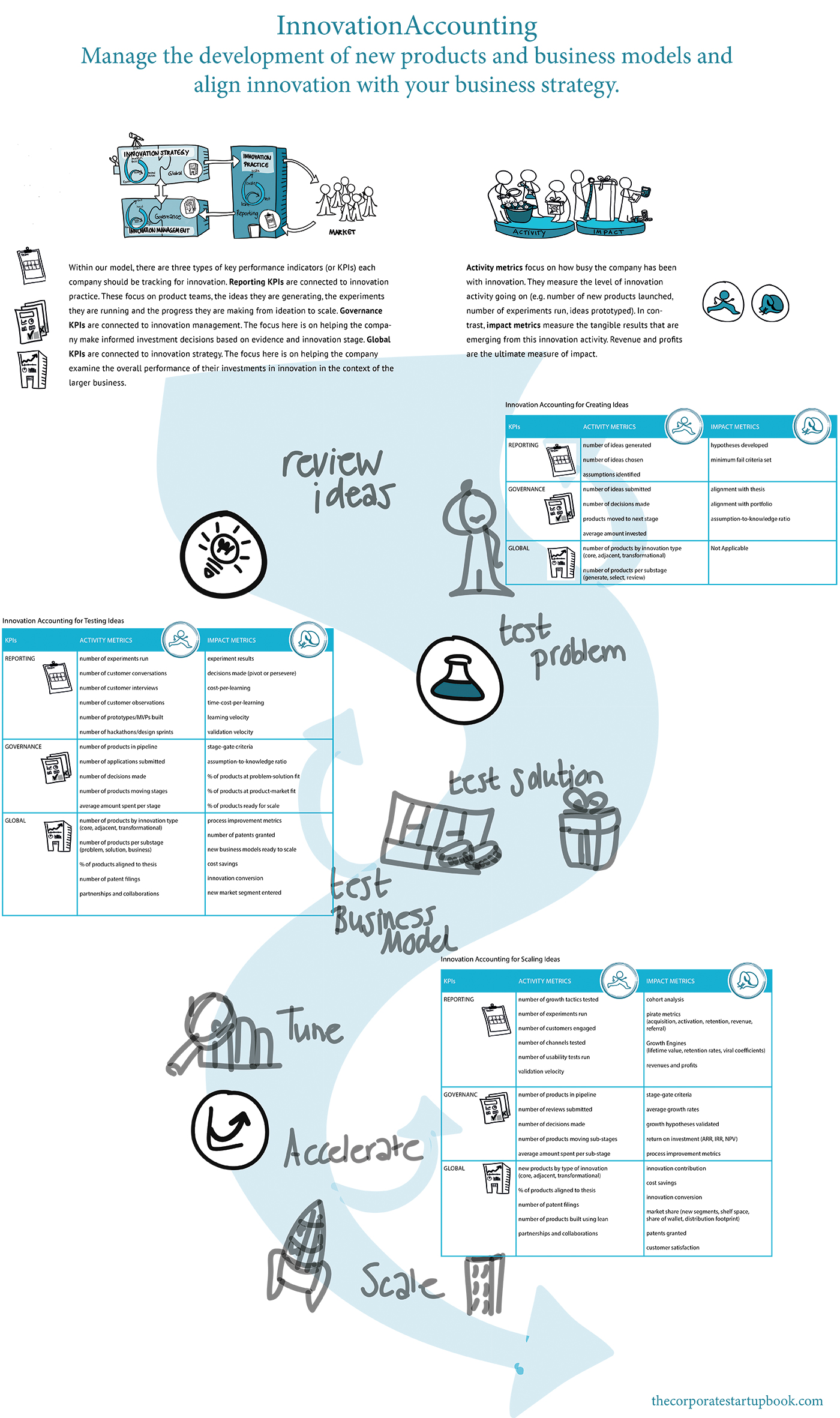Innovations-Kennzahlen, Controlling und Governance: Nichts ist im wahrsten Sinne des Wortes für Corporate Startups behinderter! Wenn der COO einer großen, globalen Organisation auf einem Demo Day unserer Innovation Kickbox das Wort "Businessplan" zu oft in den Mund nimmt, dann ist noch viel zu tun im Bereich Kennzahlen für Innovation. Steuerbare KPIs und Pläne sind für bestehende Organisationen überlebenswichtig. Aber dafür gibt es schon seit längerem Antworten, darunter die "Innovation Readiness Levels" von Steve Blank.
Die mit mir befreundeten Autoren von "The Corporate Startup Book" haben nun eine tolle Übersicht jener neuen Kennzahlen erstellt, die beim Aufbau neuer Innovationseinheiten wirklich eine Rolle spielen. Wie auch "Pläne", so sind traditionelle Kennzahlen bei neuen meist Innovationsvorhaben unbrauchbar. Dan Toma et al unterscheiden hierbei zwischen "Activity Metrics" und "Impact Metrics".
Da ich Impact liebe, hier meine 3 Lieblings-Kennzahlen:
1. Pirate Metrics
Warum? Weil der AARRR-Funnel prima visualisierbar ist und die einzelnen Stufen des Trichters logisch zusammenhängen: Acquisition, Activation, Retention, Revenue und Referral sind alles notwendige Produktkennzahlen, die ein Produkt oder Service zum fliegen bringen - mit der ersten Landingpage oder MVP sollten diese Basis-KPIs erhoben werden.
2. Cost-per-Learning
Warum? Niemand sieht, wie viel Lean Startup, Design Thinking etc. eigentlich gegenüber klassischer Wasserfall-Projekte an Ressourcen sparen! Bei einem Projekt mit Lastenheft können schon mal 6 Monate und 500.000 Euro verbrannt werden, bis dem Kunden auffällt, dass die Lösung oder das Feature nicht gebraucht wird. Durch Design Sprints und dem Mindset, dass ich eine Idee teste, bevor ich sie entwickle oder launche, spart man sich viel Frustration. Bei der Kickbox rede ich auch gerne von den "Kosten je Scheiterungsvorgang" - welcher sich auf wenige Woche und unter 10.000 Euro bewegt.
3. Learning Velocity
Warum? Weil ich genügend (echte) Startup-Teams kenne, die teilweise "0" pro Woche haben. Es nervt einfach nur noch ansehen zu müssen, wie Teams Luftschlösser wochenlang bauen, ohne ein einziges Learning aus dem echten Markt zu beziehen. Dabei sind gute Kundeninterviews quasi kostenlos und bringen innerhalb weniger Stunden große Aha-Momente (siehe: Der Mom Test).
Was mir noch fehlt sind Kennzahlen, die die Team-Dynamik, Motivation & -Organisation betrifft. Dazu werde ich später mal mehr schreiben. Hier sind weitere Kennzahlen, um Innovationsprojekte messbar zu machen:
Die mit mir befreundeten Autoren von "The Corporate Startup Book" haben nun eine tolle Übersicht jener neuen Kennzahlen erstellt, die beim Aufbau neuer Innovationseinheiten wirklich eine Rolle spielen. Wie auch "Pläne", so sind traditionelle Kennzahlen bei neuen meist Innovationsvorhaben unbrauchbar. Dan Toma et al unterscheiden hierbei zwischen "Activity Metrics" und "Impact Metrics".
Da ich Impact liebe, hier meine 3 Lieblings-Kennzahlen:
1. Pirate Metrics
Warum? Weil der AARRR-Funnel prima visualisierbar ist und die einzelnen Stufen des Trichters logisch zusammenhängen: Acquisition, Activation, Retention, Revenue und Referral sind alles notwendige Produktkennzahlen, die ein Produkt oder Service zum fliegen bringen - mit der ersten Landingpage oder MVP sollten diese Basis-KPIs erhoben werden.
2. Cost-per-Learning
Warum? Niemand sieht, wie viel Lean Startup, Design Thinking etc. eigentlich gegenüber klassischer Wasserfall-Projekte an Ressourcen sparen! Bei einem Projekt mit Lastenheft können schon mal 6 Monate und 500.000 Euro verbrannt werden, bis dem Kunden auffällt, dass die Lösung oder das Feature nicht gebraucht wird. Durch Design Sprints und dem Mindset, dass ich eine Idee teste, bevor ich sie entwickle oder launche, spart man sich viel Frustration. Bei der Kickbox rede ich auch gerne von den "Kosten je Scheiterungsvorgang" - welcher sich auf wenige Woche und unter 10.000 Euro bewegt.
3. Learning Velocity
Warum? Weil ich genügend (echte) Startup-Teams kenne, die teilweise "0" pro Woche haben. Es nervt einfach nur noch ansehen zu müssen, wie Teams Luftschlösser wochenlang bauen, ohne ein einziges Learning aus dem echten Markt zu beziehen. Dabei sind gute Kundeninterviews quasi kostenlos und bringen innerhalb weniger Stunden große Aha-Momente (siehe: Der Mom Test).
Was mir noch fehlt sind Kennzahlen, die die Team-Dynamik, Motivation & -Organisation betrifft. Dazu werde ich später mal mehr schreiben. Hier sind weitere Kennzahlen, um Innovationsprojekte messbar zu machen:
Quelle: thecorporatestartupbook.com
Welche Kennzahlen findest du besonders interessant, und warum?


 RSS-Feed
RSS-Feed